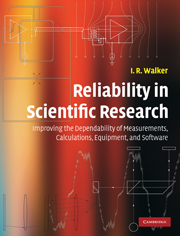 Reliability in Scientific Research
Reliability in Scientific Research Published online by Cambridge University Press: 05 June 2012
Introduction
Among the most common problems encountered when dealing with electronic items are those caused by faulty contacts, connectors, wires and cables. For example, bad solder joints are among the most frequent causes of failures in electronic devices in general. In any given electronic system, the most unreliable components will be its connectors and cables. (Perhaps somewhat surprisingly, the number of connector problems that occurred during the Apollo space program was greater than that of all other problems combined.) More specifically, faulty connectors and cables are an important source of trouble in experimental work, in the form of unreliable measurements and wasted time.
Information on this subject is widely dispersed. The purpose of the following chapter is to bring together knowledge about these mundane but troublesome items from some of the various scattered sources.
Some contact, connector, wire, and cable problems are:
(a) excessively high or low resistances, or complete open or short circuits,
(b) noisy contacts (perhaps in the form of 1/f noise),
(c) production and reception of electromagnetic interference (including crosstalk between nearby wires and cables),
(d) leakage currents over insulators in high-impedance circuits,
(e) noise produced as a result of cable vibrations in high-impedance circuits (“microphonics”),
(f) nonlinear I–V characteristics of poor-quality contacts (i.e. they can become non-ohmic – this may lead to interference with sensitive measurements due to rectification of electromagnetic noise in the environment, and also signal distortion),
(g) reflections on cables at radio (and particularly microwave) frequencies, owing to impedance mismatches,
(h) arcing and corona discharge at contacts, and in cables and connectors, at high voltages,
[…]
To save this book to your Kindle, first ensure [email protected] is added to your Approved Personal Document E-mail List under your Personal Document Settings on the Manage Your Content and Devices page of your Amazon account. Then enter the ‘name’ part of your Kindle email address below. Find out more about saving to your Kindle.
Note you can select to save to either the @free.kindle.com or @kindle.com variations. ‘@free.kindle.com’ emails are free but can only be saved to your device when it is connected to wi-fi. ‘@kindle.com’ emails can be delivered even when you are not connected to wi-fi, but note that service fees apply.
Find out more about the Kindle Personal Document Service.
To save content items to your account, please confirm that you agree to abide by our usage policies. If this is the first time you use this feature, you will be asked to authorise Cambridge Core to connect with your account. Find out more about saving content to Dropbox.
To save content items to your account, please confirm that you agree to abide by our usage policies. If this is the first time you use this feature, you will be asked to authorise Cambridge Core to connect with your account. Find out more about saving content to Google Drive.